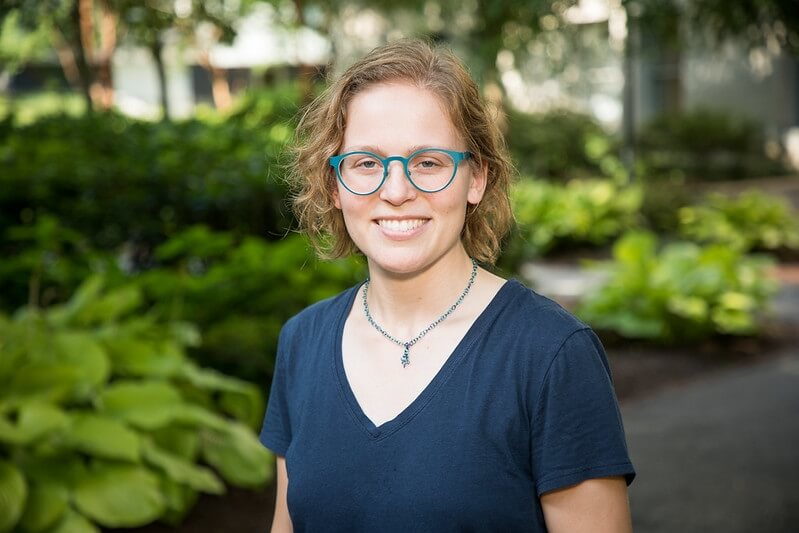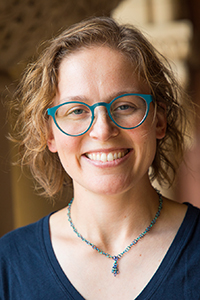News
Like faculty around the country, Elena Glassman, Assistant Professor of Computer Science at the Harvard John A. Paulson School of Engineering and Applied Sciences (SEAS), scrambled to transition her design course to entirely online delivery. Between Harvard’s mid-March decision to send students home in order to “de-densify” the campus, and the post-spring break resumption of classes, she had roughly 10 days to revise her teaching for remote delivery.
Glassman has converted her course, Design of Useful and Usable Interactive Systems (CS 179), into podcast form, where she interviews expert researchers on topics that would normally be discussed through lectures. This method allows students in different time zones to listen at their own pace and provide reflections. (Photo courtesy of Eliza Grinnell/Harvard SEAS)
In its pre-pandemic, in-person version, the 70 students enrolled in Design of Useful and Usable Interactive Systems (CS 179), gathered in the Stephanie F. Connaughton Room at SEAS. The skylit space, originally the top-floor drafting room of Pierce Hall when it opened in 1901, is today a flat, flexible classroom featuring tables and chairs on wheels at which small teams can be formed and quickly reconfigured.
Glassman used a “flipped classroom” model, with a 30-minute mini-lecture to introduce the day’s topic, followed by individual and group exercises, in which students practiced applying insights from the lecture to their group design projects.
Students are asked to explore human-computer interaction challenges, ideate solutions, gather evidence, and communicate their approach effectively as they iterate.
“The format entails brainstorming, ideation, and introspection on the part of the students,” says Glassman, who is also a Stanley A. Marks and William H. Marks Assistant Professor at the Radcliffe Institute. “The big question was whether the psychological safety I’ve strived to develop in the class would transfer to this new online infrastructure. It takes courage to sketch something and share it on a document camera with 69 others.”
Based on her experience in week one of remote instruction, Glassman abandoned the goal of synchronous delivery to students situated in time zones around the world. In some ways, this liberated her to become more creative in how she curated course materials.
“For every topic we talk about, there’s an expert out there, and many are my friends,” Glassman says. “So instead of talking to a wall in my home studio—a.k.a. my dining room—I can talk directly to the experts, record our conversation, and edit it down into an engaging podcast.”
Another advantage: the podcasts allow greater flexibility to students who, in their new lives, may be taking care of younger sibling or older relatives. They can listen at their convenience, perhaps while taking a run or walk, instead of having to stare at a screen.
Glassman says she received some pushback about the audio-only format from students who learn best when they have something to look at and she has explored options for adding a visual component to accompany each episode.
Creating an engaging podcast requires significant effort compared to recording a solo lecture. For her first two episodes, Glassman estimates she spent an average of 4.5 hours to plan, record and edit each 45-minute podcast. She recently invited each of her six teaching fellows to join her in interviewing an expert of their choice.
“It was really fun to see one of our TFs gush over Zoom to a researcher she’d followed online and finally got to talk to.”
A common regret faculty express about teaching remotely is that, especially for high-enrollment classes, they have lost the ability to read the room. Professors rely on looking at students’ faces to discern whether they are getting material across. Glassman has found another way to track student engagement.
Students have 24 hours to listen to each podcast once it is posted. Glassman asks them to spend 10 minutes reflecting on the recorded conversation and its implications for the students’ creative process and their group project. They then submit a paragraph on the course Canvas site, discuss their ideas with the other people in their group, and develop a group answer to post on a discussion forum so students can see what others took away from the lecture.
“The solo answer helps me make sure that students got something out of the lecture,” she says. “In this different format, where I’m not relying on people to raise their hands, I get to read everybody’s 10-minute reflection on my lecture. I get a more thorough understanding of what got across and that is thrilling; I never had that before.”
She adds: “For the group work portion, now I get to hear from every group, and I comment on every group, whereas in the past only the brave people in groups shared.”
“I do look forward to going back to the physical classroom, but when I do I may ask future students to continue to listen to these podcasts in preparation for my lecture, and ask students to submit solo reflections so I can read them rather than relying on hands raised in class.”
Glassman’s podcasts are posted on her faculty website and available to all.
Topics: Academics
Cutting-edge science delivered direct to your inbox.
Join the Harvard SEAS mailing list.
Scientist Profiles
Elena Leah Glassman
Assistant Professor of Computer Science
Press Contact
Paul Karoff




